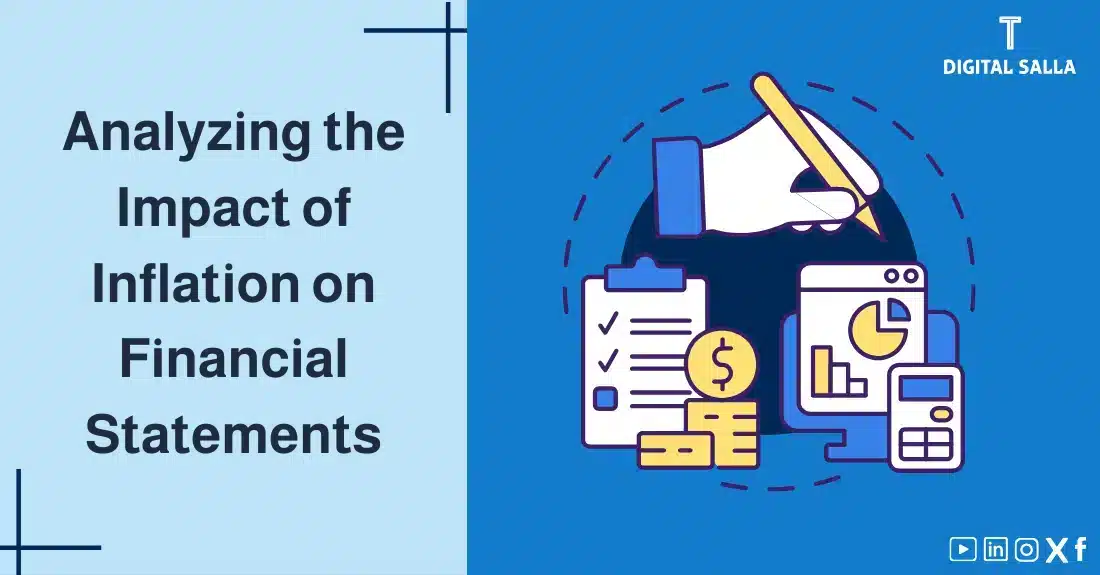Analyzing the Impact of Inflation on Financial Statements

Inflation is an economic phenomenon that indicates a continuous rise in the general level of prices of goods and services in a specific economy over a specific period. The Impact of Inflation on Financial Statements is not limited to the purchasing power of individuals, but also extends to companies, where it directly affects the financial statements and distorts the accounting figures, which may lead to incorrect decisions by investors and other stakeholders.
In this article, we will analyze the Impact of Inflation on Financial Statements, discussing how it affects the items of the statement of financial position, the income statement, and the statement of cash flows, focusing on the accounting methods used to address this challenge, such as the adjusted cost model and the current cost model, as well as highlighting the importance of understanding this impact for making sound financial and investment decisions.
What is Inflation?
Inflation is an economic phenomenon that indicates a continuous increase in the general level of prices of goods and services in a specific economy over a specific period. Inflation leads to a decrease in the purchasing power of money, where fewer goods and services can be purchased with the same amount of money.
How Does Inflation Affect Financial Statements?
Inflation significantly affects financial statements, especially when historical cost is used as the basis for measurement. Here’s the Impact of Inflation on Financial Statements:
- Impact of Inflation on the Statement of Financial Position:
- Fixed Assets: Fixed assets, such as buildings and machinery, appear in the statement of financial position at their historical cost adjusted for depreciation. Under inflation, the market value of these assets is much higher than their book value, leading to the financial statements not representing economic reality.
- Inventory: Inflation affects inventory valuation, especially when using the First-In, First-Out (FIFO) method. Under inflation, the FIFO method shows a higher inventory value in the statement of financial position and a lower cost of goods sold in the income statement, leading to inflated profits.
- Accounts Receivable: Inflation leads to a decrease in the purchasing power of money, so collecting receivables in the future means receiving amounts with lower purchasing power.
- Cash: The purchasing power of cash decreases with inflation, leading to an unrealized loss.
- Liabilities: Generally, companies benefit from inflation with regard to long-term liabilities with fixed interest, as the real value of these liabilities decreases with inflation.
- Impact of Inflation on the Income Statement:
- Cost of Goods Sold: Inflation leads to an increase in the cost of goods sold, especially when using the FIFO method, which leads to a decrease in gross profit.
- Depreciation Expense: Depreciation expense is calculated based on the historical cost of assets, which is lower than their market value under inflation. This leads to lower depreciation expense and inflated profits.
- Operating Profit and Net Profit: Inflation affects operating profit and net profit through its impact on the cost of goods sold and depreciation expense. The financial statements may show misleading profits that do not reflect economic reality.
- Impact of Inflation on the Statement of Cash Flows:
- Cash Flows from Operating Activities: The financial statements may show higher operating cash flows under inflation due to the decrease in the real value of cash payments related to accrued expenses and other liabilities.
- Cash Flows from Investing Activities: The financial statements may show larger cash outflows when purchasing new fixed assets under inflation, as the cost of these assets increases.
- Cash Flows from Financing Activities: Companies may benefit from inflation when repaying long-term loans with fixed interest, as the real value of these loans decreases.
Accounting Methods Used to Address the Impact of Inflation:
- Adjusted Cost Model: Under this model, assets and liabilities are revalued to reflect their current value under inflation. Various methods can be used for revaluation, such as using price indexes or independent valuations.
- Current Cost Accounting: Similar to the adjusted cost model, but it focuses on measuring assets and liabilities at their current replacement cost.
Advantages of Using the Adjusted Cost or Current Cost Model:
- Providing More Relevant Information: Financial statements adjusted for inflation reflect economic reality better than financial statements prepared according to historical cost.
- Improving the Quality of Decisions: Inflation-adjusted financial information helps in making more accurate investment and financing decisions.
- Assessing Performance More Fairly: Companies’ performance can be assessed more fairly when using financial statements adjusted for inflation.
Disadvantages of Using the Adjusted Cost or Current Cost Model:
- Complexity: These models require the use of estimates and judgment, which can lead to differences in application between companies.
- Cost: The cost of applying these models can be high, especially for small companies.
- Lack of Widespread Acceptance: These models are not widely accepted by accounting standard-setting bodies and are not considered a recognized alternative to International Financial Reporting Standards in most countries.
IAS 29 “Financial Reporting in Hyperinflationary Economies”:
IAS 29 “Financial Reporting in Hyperinflationary Economies” addresses how to prepare financial statements under high inflation rates. IAS 29 requires remeasuring items in the financial statements using a conversion factor that reflects changes in the purchasing power of money.
Importance of Analyzing the Impact of Inflation on Financial Statements:
Analyzing the Impact of Inflation on Financial Statements is essential for understanding the entity’s true financial performance, especially in hyperinflationary economies. This analysis helps in:
- Assessing Financial Performance More Accurately: Inflation can distort financial statement figures, leading to an inaccurate assessment of the entity’s performance. Analyzing the Impact of Inflation on Financial Statements helps in obtaining a clearer picture of true performance.
- Making Better Investment Decisions: Analyzing the impact of inflation helps investors make more informed investment decisions by understanding the Impact of Inflation on Financial Statements, and on the value of assets and profitability.
- Assessing the Entity’s Ability to Continue: High inflation can erode capital and weaken the entity’s ability to continue. Analyzing the Impact of Inflation on Financial Statements helps in assessing the entity’s ability to continue under these conditions.
- Identifying Potential Risks and Problems: Analyzing the Impact of Inflation on Financial Statements can help identify potential risks and problems that the entity may face in the future.
- Understanding the Impact of Inflation on Cash Flows: The analysis helps in understanding how inflation affects the entity’s cash flows and its ability to generate cash and meet its obligations.
How to Analyze the Impact of Inflation on Financial Statements:
- Revaluation of Assets and Liabilities: Non-monetary assets and liabilities should be revalued to reflect their current value under inflation. Price indexes or independent valuations can be used for this purpose.
- Adjusting Items in the Income Statement: Items in the income statement, such as cost of goods sold and depreciation expense, should be adjusted to reflect the impact of inflation.
- Calculating Gains and Losses Resulting from Inflation: Gains and losses resulting from changes in the purchasing power of money should be calculated and recognized in the financial statements.
- Preparing Inflation-Adjusted Financial Statements: Inflation-adjusted financial statements can be prepared to show the Impact of Inflation on Financial Statements more clearly.
- Using Financial Ratios: Inflation-adjusted financial ratios can be used to assess the entity’s performance and financial position more accurately.
Role of Technology in Analyzing the Impact of Inflation:
Accounting Software and Enterprise Resource Planning (ERP) systems help in analyzing the Impact of Inflation on Financial Statements through:
- Automating the process of revaluing assets and liabilities.
- Calculating gains and losses resulting from inflation.
- Issuing inflation-adjusted financial statements.
- Performing sensitivity analyses to assess the impact of different inflation rates.
- Improving the accuracy and efficiency of the process of analyzing the impact of inflation.
Example of the Impact of Inflation on Financial Statements:
Situation: Company “A” purchased a piece of land in 2020 for 100,000 Riyals. In 2023, the cumulative inflation rate reached 20%.
Impact on the Statement of Financial Position:
- According to historical cost: The land will appear in the statement of financial position for 2023 at 100,000 Riyals.
- After adjusting for inflation: The land will appear in the statement of financial position for 2023 at 120,000 Riyals (100,000 x 1.20).
Impact on the Income Statement:
- If the company sold the land in 2023 for 130,000 Riyals, a profit of 30,000 Riyals would be recognized according to historical cost.
- But after adjusting for inflation, a profit of only 10,000 Riyals (130,000 – 120,000) would be recognized.
Conclusion
Inflation is an important economic factor that significantly affects the financial statements of entities. Companies must consider the Impact of Inflation on Financial Statements when preparing them, especially in hyperinflationary economies. Understanding how inflation affects financial statements is essential for accountants, auditors, investors, and anyone seeking to understand the entity’s true financial performance. By using appropriate accounting methods, such as the adjusted cost model and the current cost model, companies can present the Impact of Inflation on Financial Statements more accurately and transparently. Finally, technological developments facilitate the process of analyzing the Impact of Inflation on Financial Statements and improve the quality and accuracy of the financial information provided.
